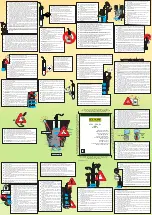
Mighty Therm Volume Water Heater
Page 7
maintain clearances and prevent physical damage
and separation of joints.
4.
Avoid ending heater vents near air conditioning
or air supply fans. The fans can pick up exhaust
flue products from the heater and return them
inside the building, creating a possible health
hazard. A minimum of 4 feet horizontal distance
must be maintained from electrical meters, gas
meters, and relief equipment.
5.
Always use double-wall or insulated vent pipe
(Type B or equivalent). In cold weather,
uninsulated outside vents can chill the rising flue
products, blocking the natural draft action of the
venting system. This can create a health hazard
by spilling flue products into the heater room.
6.
Avoid oversize vent piping or extremely long
runs of the pipe which may cause excessive
cooling and condensation. Rule of Thumb: The
total length of the vent, including the connector
and any offset, should not exceed 15 feet for
every inch of vent diameter. Longer total lengths
shown in venting tables are based on maximum
capacity, not condensation factors.
7.
When the installation of a draft fan is necessary
in connecting a venting system to a Laars heater,
the installation should be engineered by
competent personnel following good engineering
practices. The draft fan supplier should be
consulted for correct size. The installation should
be in accordance with the latest edition of ANSI
Z223.1 and/or, in Canada, CAN1-B149
requirement and any local codes having
jurisdiction. When a draft fan is installed, a
suitable draft switch must be wired into the
heater control circuit at terminal designated
“Field Interlock” to prevent firing of the heater
unless a positive draft has been established.
2C. Installation of Outdoor Heaters
1.
Locate the heater to provide the minimum
clearances as listed in Table 1, “Placement of
Heater”.
2.
Do not place the heater in an enclosure or wall
recess. Avoid locations where wind deflection
off structures might cause down draft. When
such wind conditions are possible, place the
heater at least three (3) feet from the structures.
3.
Never install the heater under any kind of roof
overhang. Do not place the heater below or
adjacent to any doors, windows, louvers, grills,
etc. which connect in any way with an inhabited
area of a building. This includes other structures
such as garages or utility rooms (see Figure 7).
4.
Although these models are AGA and CGA
designed certified for outdoor installations, such
installations are not recommended in areas where
Figure 7. Incorrect Outdoor Installation.
the danger of freezing exists unless proper
precautions are taken for freeze protection.
2D. Gas Supply and Piping
Review the following instructions before
proceeding with the installation.
1.
Verify that the heater is fitted for the proper type
of gas by checking the rating plate. Laars heaters
are normally equipped to operate below a 2000
foot altitude. Heaters equipped to operate at
higher altitudes have appropriate stickers or tags
attached.
2.
Use the figures in Table 3 to provide adequate
gas piping from the gas meter to the heater.
3.
A trap (drip leg) must be provided ahead of the
gas controls (see Figure 8 ). A manual gas
shutoff valve must also be provided for service
convenience and safety. Check the local codes.
Table 3. Gas Piping Sizes.
Distance from Gas Meter
or Last Stage Regulator
Size
0-100'
100-200'
200-300'
500
600
715
850
1010
1200
1430
1670
1825
1-1/2"
1-1/2"
2"
2"
2"
2-1/2"
2-1/2"
2-1/2"
2-1/2"
2"
2"
2"
2-1/2"
2-1/2"
3"
3"
3"
3"
2"
2-1/2"
2-1/2"
2-1/2"
3"
3"
3"
3"
3-1/2"
Note: These figures are for Natural Gas (.65 Sp. Gr.), and are
based on 1/2" water column pressure drop. Check supply
pressure with a manometer, and local code requirements for
variations. For LPG, reduce pipe diameter one size, but maintain
a 1" minimum diameter. A normal number of Tees and elbows
have been taken into allowance.








































